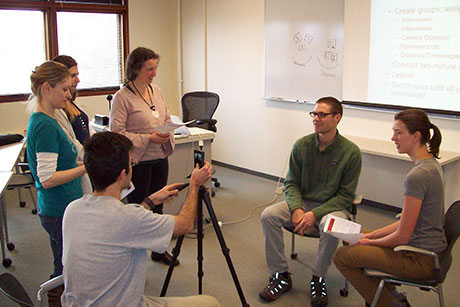Class teaches science storytelling to scientists
By Alex Koeberle

A scientist who wants to demonstrate why coral reefs are beautiful can simply show a picture of vibrant fish in transparent water. But explaining causes of coral reef bleaching to readers who took high school chemistry class 20 years ago is a daunting task.
Scientists face many challenges when trying to share their discoveries to the public, which is why Bruce Lewenstein, Cornell professor of communication, leads an annual weekend workshop to teach science storytelling to scientists.
“The lab alone is not science. Communication is fundamental for reliable knowledge,” Lewenstein said. “Thinking in these terms, communication with the public is an integral part of the scientific process.”
From urban horticulturists to mosh pit physicists, 20 Cornell graduate students from a variety of backgrounds came together March 1-3 for Communications 5660, a one-credit class offered each spring for graduate students and postdocs. In addition to tailoring scientific writing to general audiences, participants learn how to effectively use social media such as Twitter and blogs.
“The advantage of social media is that scientists can now communicate their findings directly with the public, a great way to spread knowledge to a large audience,” Lewenstein said.
One of the class panelists, Lesley Yorke, public affairs officer for University Communications, agreed. “The avenues for science communication have grown exponentially,” said Yorke. “It is important for science communicators to take advantage of all these different channels, especially online media.”
Students also had the opportunity to conduct mock interviews – as both the interviewer and interviewee – in front of a live camera.
Language – especially technical jargon – is a struggle because it can be difficult to give up precision, Lewenstein said. There are also structural challenges, since the public wants to know more background information.
“Really the whole process is inverted,” Lewenstein said. “Scientists give an introduction, a description of the research, then the conclusion. In writing for the public, tell them what you found first, then give the context. It’s the opposite of the traditional scientific paper.”
Lewenstein recommends using word images and analogies to tell a narrative. For effective communication, the story should be focused on the quest rather than the finding.
“Tell a person-story,” he advises. “What drove you to spend 20 hours straight in the lab? What challenges did you face as a person?”
“To communicate effectively in science, you, as a scientist, need to help the individual understand the relevance of your work to his or her life,” said Yorke.
When helping scientists, Yorke recommends three important questions: Who is your audience? What do you want to communicate? What do you want the outcome to be?
“Effective science communicators are able to keep it simple, use strong examples and are prepared to answer difficult questions,” Yorke said.
Lewenstein said he has noticed that over the past 20 years, more and more traditional science training programs are including social context and communication.
“There is a tremendous need for communication integrated into undergraduate programs as well,” Lewenstein said. “A well-rounded education in the sciences is about building skills and perspective.”
Alex Koeberle ’13 is a student writer for the College of Agriculture and Life Sciences.
Media Contact
Get Cornell news delivered right to your inbox.
Subscribe